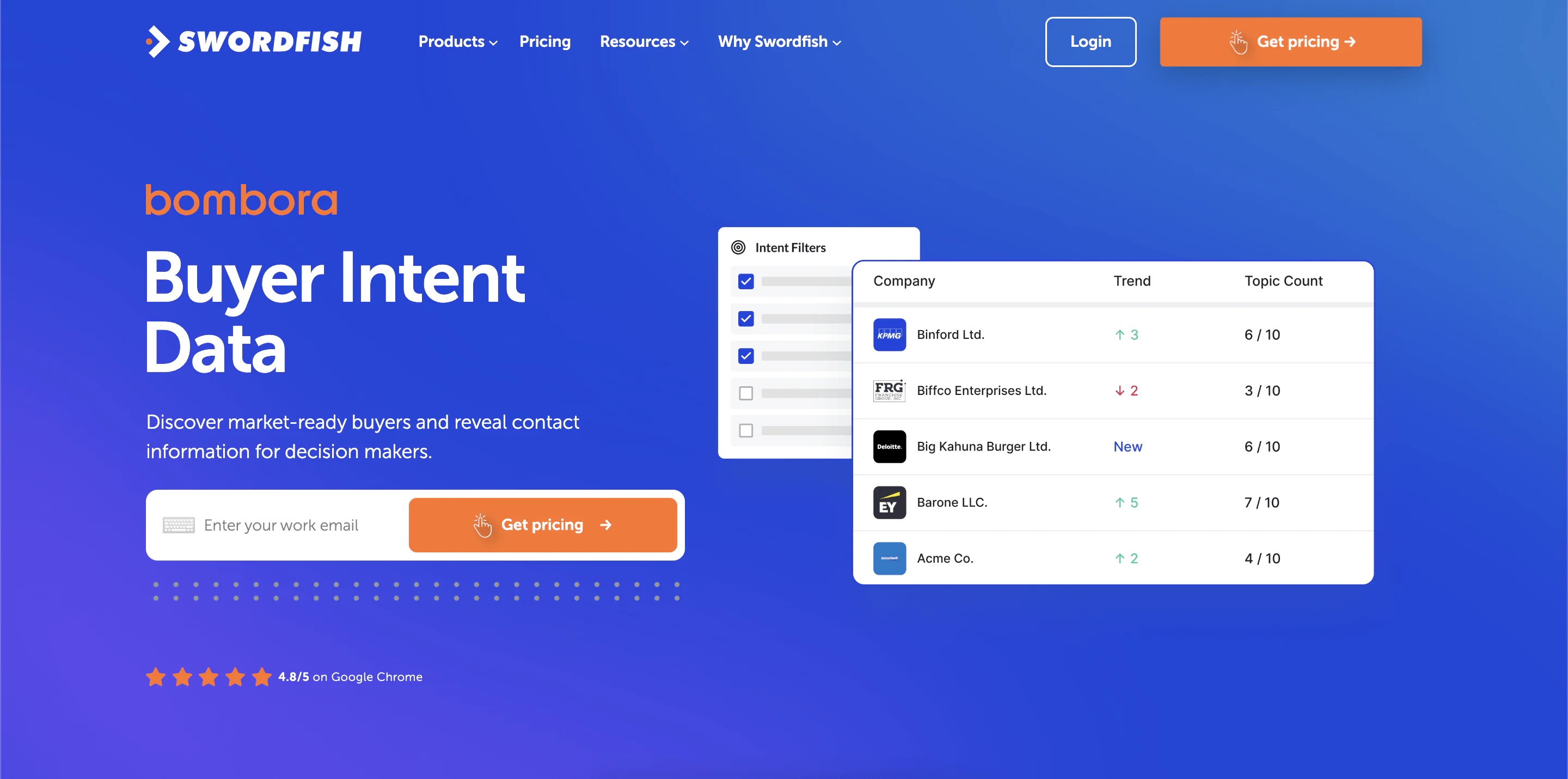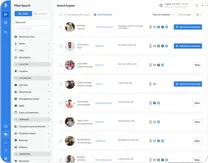
Prospecting is more than just a part of the sales process; it’s a skillful blend of strategy, psychology, and determination. Its standout feature is turning unfamiliar contacts into interested leads, opening up new possibilities for revenue.
This first step in finding potential customers is a mix of creative thinking and analytical ability. That being said, it’s a crucial yet challenging phase in sales. A report shows that 42% of sales reps find it the toughest part of their job.
It reflects the complexity of prospecting, which relies on smart tactics and personal touch. That’s where prospecting strategies come in to offer a clear way to identify and reach out to potential clients.
It’s not just about generating any leads, but about finding the right ones. Next, we will explore the details of prospecting strategies, providing insights and actionable advice to excel in this essential phase of sales.
What is Prospecting?
Prospecting is the first step in selling, where businesses look for potential customers for their products or services. Companies often use methods like cold calls, mass emails, and texts to find people who might become valuable customers.
It also helps rekindle interest among potential customers who previously showed interest but didn’t make a purchase.
Sales Prospecting Methods
The ways salespeople find new leads or keep in touch with existing ones are known as sales prospecting methods. These methods can be different for each sales team and industry. They include reaching out through emails, connecting on social media, networking at events, and making warm phone calls.
Traditionally, prospecting had two main types: outbound and inbound.
1. Outbound Prospecting
In outbound prospecting, salespeople reach out to potential customers who haven’t shown prior interest, often through cold calls or emails.
2. Inbound Prospecting
It’s the opposite, focusing on building relationships and contacting only those who have already shown interest in the product or service.
Nowadays, most sales experts believe that the best approach is a mix of both inbound and outbound strategies. This combination is often seen in effective prospecting strategies, such as direct outreach and relationship-building to reach new customers.
Why is Sales Prospecting Important?
Sales prospecting is crucial because it helps you find and connect with potential customers who need what you’re offering. You can approach people who are more likely to be interested in your products if you understand their challenges.
This approach isn’t just theoretical; it works in practice. Research by RAIN Group shows that over 71% of buyers appreciate hearing from salespeople early in their decision-making process.

Impressively, 82% of buyers are open to meetings if a salesperson contacts them first. The most successful salespeople are those who actively engage in prospecting. They are able to set up three times more sales meetings compared to those who don’t prospect.
Effective prospecting strategies are key. When done right, they allow you to arrange meetings with leads that are a perfect match for your services or products. These well-matched customers often become long-term clients, contributing more to your business.
Lead vs Prospect: A Comparison Chart
Many salespeople get confused between a lead and a prospect. And we want to clear that out before explaining our prospecting strategies.
|
Aspects |
Lead |
Prospect |
|
Definition |
A lead is someone who has shown initial interest in your company, like visiting your website or subscribing to a blog. |
A prospect is a lead who has been evaluated and deemed a good fit for your product or service. |
|
Example |
Someone subscribes to your blog after visiting your website. |
A small construction firm owner subscribes to your blog and matches your target customer profile. |
|
Qualification |
Leads have shown interest but are not yet assessed for fit. |
Prospects are qualified leads, assessed as potential customers. |
|
Interaction Level |
Limited interaction, such as website visits or blog subscriptions. |
May have similar interactions as leads but are further qualified. |
|
End Goal |
To nurture them into becoming customers. |
To convert them into customers through targeted engagement. |
|
Process |
Nurturing from initial interest to sale. |
Engagement from qualification to sale. |
10 Best Prospecting Strategies to Make More Sales

Now let’s dive into each strategy and see how it impacts and improves your prospecting.
1. Make the Call – But Start with a Connection
Research by Rain Groups shows that phone calls are still a highly effective prospecting strategy in sales. From their study, it’s clear that different types of buyers have preferences for how they’re approached.

Those who favor phone calls include —
- Tech buyers (54%),
- C-level and VP buyers (57%),
- Directors (51%),
- Managers (47%).
For salespeople, making a ‘warm call’ – calling someone who already knows a bit about you – is often more comfortable than a ‘cold call’ to a stranger. To make a cold lead warm, the lead should already have some awareness of who you are and what you offer.
You can create this initial awareness by getting a recommendation from someone you trust or engaging with them on social media. Once you’ve sparked their interest, it’s your job to keep the conversation going.
2. Become an Expert in Your Field
To attract referrals, it’s essential to be more than just a seller. You should aim to be a trusted expert and a problem solver, as 79% of potential customers prefer sales reps who are advisors they can trust.
This requires deep knowledge of the industry you’re targeting. Research shows that 51% of top sales performers are viewed as experts in their field, while only 7% are seen merely as salespeople.
Understanding your potential customers is also crucial. People appreciate the attention and being taken seriously. You need to know not just their needs and concerns but also their successes and achievements. Research your leads thoroughly, like a detective, and use this information to strengthen your pitch.
Deep product knowledge is crucial. Since 54% of potential customers expect to learn how your product functions in the first call, be ready to describe its main features and give real-world examples clearly. It’s one of the best prospecting strategies for consulting firms.
3. Choose Your Words Carefully
The words and phrases you use can influence emotions and perceptions. To improve your language for better connections and lead generation, follow these tips —
- Show Respect: Always be polite and use respectful titles.
- Express Gratitude: Thank your prospects for their time and express appreciation for the conversation.
- Understand Jargon: Explain any industry-specific terms in simple language.
- Maintain Integrity: Speak positively about past collaborations.
- Guide: Employ solution-focused language, offering guidance and support.
- Avoid Bias: Use fair and equal language.
- Address Needs: Be receptive and accommodating to the client’s ideas and queries.
4. Use a Script Wisely
For beginners, a basic script can help avoid awkward pauses, ensure appropriate language, and tackle common objections in sales prospecting strategies. Experienced sales reps often skip scripts to sound more natural.
Yet, some seasoned professionals use well-practiced scripts that sound spontaneous. Regardless of using a script, always listen actively to your prospects and tailor the conversation to their needs.
5. Strengthen Your Social Media Presence
Social media is a permanent fixture today. Platforms like Twitter, Facebook, LinkedIn, and YouTube are where your potential customers gather information. If you’re not active there, you’re missing out!
Here’s why social media matters in best prospecting strategies —
- 84% of top executives use social media for making purchase decisions (Source).
- 91% of B2B buyers use social media actively (Source).
- 78% of salespeople active on social media outsell their peers (Source).
The takeaway? Social selling is effective.
If you’re unsure where to begin, start small. Create a profile on a key social media platform relevant to your industry. For B2B, LinkedIn is crucial.
A strong LinkedIn presence is vital, as 82% of buyers check out vendors on LinkedIn before responding to sales efforts, and 70% of sales reps use it for prospecting and closing deals.
Remember, social media is an addition to your prospecting toolkit, not a replacement for other methods.
6. Encourage Customer Referrals
A satisfied customer is your best advocate. They’re likely to spread positive feedback about your service. An impressive 73% of executives prefer dealing with salespeople introduced through personal connections.
Don’t miss this cost-free chance – ask your customers for referrals. Sales reps who actively pursue referrals can earn up to five times more than those who don’t, yet only 11% do.

Prospecting strategies for financial advisors can greatly benefit from this approach. The ideal time to request a referral is right after completing a sale. It’s equally crucial to maintain contact with current customers.
Check-in with them to ensure they’re still pleased with your product or service. Organize a casual sales meeting to catch up, or invite them to relevant events. Share useful resources like whitepapers to keep your business in their thoughts.
7. Balance Talking and Listening
Research shows that the best sales reps spend more time listening than talking. It’s especially important in cold prospecting strategies.

During a cold call, it’s tempting to talk at length about your product or service’s benefits. However, it’s crucial to resist this urge.
Instead, make your calls more interactive. Ask open-ended questions to encourage the prospect to speak. This approach serves two purposes:
- It makes the prospect feel heard and valued.
- It gives you insights into their specific needs, allowing you to tailor your pitch to their unique challenges and requirements.
8. Use Video to Showcase Your Sales Skills
Video is quickly becoming a key tool for sales prospecting, and it’s something you might not have tried yet. The trend is shifting towards using videos for both marketing and sales outreach. We’re not talking about high-end corporate videos with overly polished scenes.
Instead, think of simple, homemade videos where you, as a sales representative, can introduce yourself, provide information, share statistics, and deliver your best sales pitch in a unique way.
Remember, people prefer buying from real people. So, let your authenticity shine through in your videos! Videos are an effective medium for engaging and educating potential buyers.
Moreover, 80% of buyers have bought an app or software after watching a brand’s video. Don’t miss out on this growing trend.
9. Avoid Rushing into Selling
Prospecting is just the beginning of the sales process, not the actual act of selling. It involves finding potential leads, who are then evaluated and added to the sales funnel. Selling only starts after these steps are completed.
In modern sales, it’s crucial to concentrate on establishing relationships during the prospecting phase. If you start selling too soon, you risk pressuring the potential customer. By first creating a trustful relationship, both you and the prospect will feel more at ease.
This way, when you do start using sales techniques, they’re likely to be more successful.
10. Persist with Follow-Ups
Success in sales often doesn’t come from the first interaction. Moving a lead towards a sale takes effort, involving multiple follow-up emails, phone calls, and sharing additional information. Prompt follow-ups are key to building a relationship and showing your commitment and reliability.
It turns out that 42% of buyers say they’re more likely to make a purchase if a sales rep follows up at the agreed time. Simple actions, like a ‘just checking in’ message, a ‘thank you’ note, or timely delivery of a proposal or product details, significantly boost your chances of closing a sale.
If you don’t get a response to an email within 24 hours, it’s crucial to follow up. Research indicates that there’s a 21% chance of getting a reply to your second email if the first one goes unanswered.
Utilizing Swordfish AI for Effective Sales Prospecting
At Swordfish AI, we’re uniquely equipped with a proprietary cell phone verification system and a distinct feature of providing a unique cell phone number for each user. This makes Swordfish an outstanding choice for cold-calling strategies.
Our commitment to enhancing your sales efforts doesn’t stop there. Our extensive database includes over 3.5 billion data profiles, allowing you to identify and connect with potential clients efficiently.
Our platform is designed to be user-friendly and intuitive, allowing you to focus on what you do best – building relationships and closing deals.

Features of Swordfish AI
Here are the features to help you in prospecting —
-
Reverse Search

Swordfish AI offers a reverse search feature, allowing you to find extensive contact information using limited data like name, email, company, phone, or social profile.
-
Bombora® Intent Data

The platform is set to integrate Bombora® Intent Data, enabling you to discover businesses ready to buy your product with buyer intent data.
-
Prospector Tool

Swordfish AI’s Prospector tool allows you to prospect and fuel their sales pipeline in bulk, generating leads with advanced filters and suppression.
-
Extensive Network Partnerships
The platform connects with over 200 network partners, ensuring access to the most accurate and updated contact information globally.
-
Chrome Integration for Data Extraction

You can easily integrate Swordfish AI with Chrome to extract contact information from platforms like Facebook, LinkedIn, GitHub, and through Bing and Google searches.
Conclusion
We’ve covered key prospecting strategies, focusing on the power of social media, understanding what customers want, and using advanced tools. B2B marketers and salespeople need these approaches to succeed in today’s complicated market.
Keeping up with current trends, including tailored communication and using data to target potential customers, is crucial. Remember, the world of prospecting strategies is constantly changing.
So, it’d be best to try Swordfish AI to greatly improve your prospecting work. With these methods and cutting-edge tools, you can achieve better marketing and sales results.
Frequently Asked Questions
What are the 5 P’s of prospecting?
The prospecting process breaks down into five key elements: purpose, preparation, personalization, perseverance, and practice.
Why is prospecting so hard?
Prospecting can be tough, often due to a lack of necessary tools and resources. Salespeople might struggle to find and connect with potential customers without these aids. Despite these challenges, prospecting remains a vital part of the sales cycle.
What is intelligent prospecting?
Intelligent prospecting involves using advanced tools and methods to enhance sales outreach. It helps in accurately identifying ideal prospects, improving engagement strategies, and increasing the effectiveness of sales efforts.


 View Products
View Products



